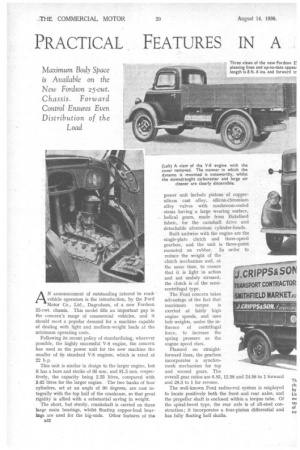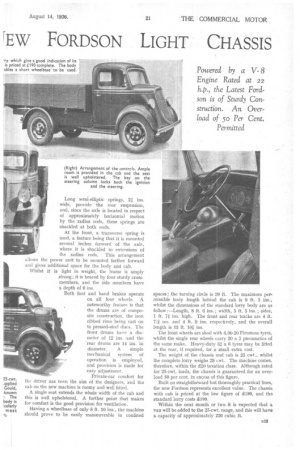PRACTICAL FEATURES IN A
Page 38

Page 39

If you've noticed an error in this article please click here to report it so we can fix it.
rEW FORDSON LIGHT CHASSIS Maximum Body Space is Available on the New Fordson 25-cwt. Chassis. Forward Control Ensures Even Distribution of the
Load
Powered by a V8 Engine Rated at 22 h.p., the Latest Fordson is of Sturdy Construction. An Overload of 50 Per Cent.
Permitted
AN announcement of outstanding interest to roadvehicle operators is the introduction, by the Ford Motor Co., Ltd., Dagenham, of a new Fordson 25-cwt. chassis. This model fills an important gap in the concern's range of commercial vehicles, and it should meet a popular demand for a machine capable of dealing with light and medium-weight loads at the minimum operating costs.
Following its recent policy of standardizing, wherever possible, the highly successful V-8 engine, the concern has used as the power unit for the new machine the smaller of its standard V-8 engines, which is rated at 22 h.p.
This unit is similar in design to the larger engine, but it has a bore and stroke of 66 mm. and 81.5 mm. respectively, the capacity being 2.33 litres, compared with 3.62 litres for the larger engine. • The two banks of four cylinders, set at an angle of 90 degrees, are cast integrally with the top half of the crankcase, so that great rigidity is allied with a substantial saving in weight.
The short, but sturdy, crankshaft is carried on three large main bearings, whilst floating copper-lead bearings are used for the big-ends. Other features of the 1332 power unit include pistons of coppersilicon cast alloy, silicon-chromium alloy valves with mushroom-ended stems having a large wearing surface, helical gears, made from Bakelised fabric, for the camshaft drive and detachable aluminium cylinder-heads.
The Ford concern takes advantage of the fact that maximum torque is exerted at fairly high engine speeds, and uses bob weights, under the influence of centrifugal force, to increase the 'spring pressure as the engine speed rises.
Planned on straightforward lines, the gearbox incorporates a synchromesh mechanism for top and second gears. The overall gear ratios are 6.83, 12.98 and 24.98 to 1 forward and 28.3 to 1 for reverse.
The well-known Ford radius-rod system is employed to locate positively both the front and rear axles, and the propeller shaft is enclosed within a torque tube. Of the spiral-bevel type, the rear axle is of all-steel construction; it incorporates a four-pinion differential and has fully floating half shafts.
Long semi-elliptic springs. 21 ins. wide, provide the rear suspension, and, since the axle is located in respect of approximately horizontal motion by the radius rods, these springs are shackled at both ends.
At the front, a transverse spring i3 used, a feature being that it is mounted several inches forward of the axle, where it is shackled to extensions of the radius rods. This arrangement allows the power unit to be mounted farther forward and gives additional space for the body and cab.
Whilst it is light in weight, the frame is amply strong ; it is braced by four sturdy crossmembers, and the side members have a depth of 6 ins.
Both foot and hand brakes operate on all four wheels. A noteworthy feature is that the drums are of composite construction, the iron ribbed rims being cast on to pressed-steel discs. The front drums have a diameter of 12 ins, and the rear drums are 14 ins, in diameter. A simple mechanical system of operation is employed, and provision is made for easy adjustment.
Private-car comfort for the driver nas been the aim of the designers, and the cab on the new machine is roomy and well fitted.
A single seat extends the whole width of the cab and this is well upholstered. A further point that makes for comfort is the good provision for ventilation.
Having a wheelbase of only 8 ft. 10 ins., the machine should prove to be easily manoeuvrable in confined
spaces; the turning circle is 39 ft. The maximum permissible body length behind the cab is 9 ft. 5 ins.. whilst the dimensions of the standard lorry body are as follow :—Length, 8 ft. 6 ins. ; width, 5 ft. 5 ins. ; sides, 1 ft. 71 ins. high. The front and rear tracks are 4 ft. ill ins. and 4 ft. 9 ins, respectively, and the overall length is 13 ft. 10i ins.
The front wheels are shod with 6.00-20 Firestone tyres, whilst the single rear wheels carry 30 x 5 pneumatics of the same make. Heavy-duty 32 x 6 tyres may be fitted at the rear, if required, for a small extra cost.
The weight of the chassis and cab is 25 cwt., whilst the complete lorry weighs 29 cwt. The machine comes, therefore, within the £20 taxation class. Although rated for 25-cwt. loads, the chassis is guaranteed for an overload 50 per cent. in excess of this figure.
Built on straightforward but thoroughly practical lines, the new Fordson represents excellent value. The chassis with cab is priced at the low figure of £180, and the standard lorry costs £190;
Within the next month or two it is expected that a van will be added to the 25-cwt. range, and this will have a capacity of approximately 220 cubic ft.












































































